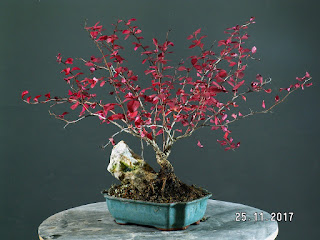Flowering quince_Trunk it...

Typical Chaenomeles has a shrubby look and this is reflected in a vast majority of bonsai made from this plant. As the life is not always straightforward, there are exceptions from any rule. No surprise there are as an exception also flowering quinces with trunks. Sometimes the trunk is just made from a taproot that is gradually exposed to the life above the ground. And this was the case with this plant. 2013 Driving on a highway, I have spotted some red flowering shrubs on the sideways. Flowering quinces scattered on the rocky earthwork surrounding the highway. Roots squeezed between the rocks, no chance to collect without preparation. I have selected one plant, removed rocks around the thick root and replace them with nice soil. Then, during the summer weeks I have stopped there now and then bringing some water. Spring 2014 Collection. First few rakes into the soil have revealed a lot of nice tiny roots. Great!? No. One of the first things you learned



